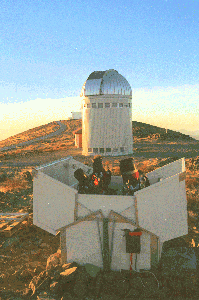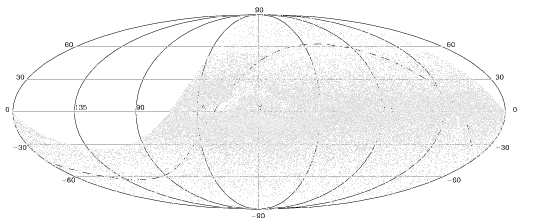ASAS overview

This is the old ASAS interface, referencing data that were
partly corrupted due to the RAID failure. Please use new ASAS home:
www.astrouw.edu.pl/asas for accessing current ASAS data. Data on
this new web page come from the independent reduction process, which led to
slightly different photometric values. Although we tried to do the best
some problems with their quality exists (e.g. data with underestimated
luminosity due to obscuration by dome or shutter). We'll try to eliminate them.
The All Sky Automated Survey
The All Sky Automated Survey is a project which final goal is photometric
monitoring of approx. 10^7 stars brighter than 14 magnitude all
over the sky.
The initial idea for the project is due to
Prof. Bohdan Paczynski of
Princeton University. The prototype instrument, located at the
Las Campanas Observatory
(operated by the Carnegie Institution of Washington),
and the data pipeline were developed by
Dr. Grzegorz Pojmanski
(mail) of the
Warsaw University Observatory.
The project is supported by a generous gift from Mr. William Golden to
B. Paczynski.
It is a pleasure to acknowledge the on site assistance by the
OGLE observers.
Low cost prototype system
ASAS-1, ASAS-2 was replaced by the
ASAS-3 system, that consists of two
wide-field 200/2.8 instruments,
one narrow-field 750/3.3 telescope and
one super-wide 50/4 scope,
each equipped with the Apogee 2Kx2K CCD camera, locataed in the
custom made automated enclosure
(shown in front of the Polish Telescope in the photograph).
ASAS-3 results:
The ASAS-3 Catalog of Variable Stars
containing over 10,000 eclipsing binaries, almost 8,000 periodic pulsating and
over 31,000 irregular stars found among 15,000,000 stars on the sky south
of the declination +28.
ASAS 2 results:
Data obtained in the years 1997-2000 are now available as:
The ASAS-2 Photometric I-band Catalog -
giving interactive access to > 50 milion measurements of > 140,000 stars;
Sky Atlas
- graphic interface to the I-band Catalog and
The ASAS-2 Catalog of Variable Stars
containing over 350 Periodic and
3500 Miscellaneous variables.
The ASAS Gallery
presents collection of the variables' light curves.
Below current coverage of the ASAS-3 system is shown in galactic coordinates:



